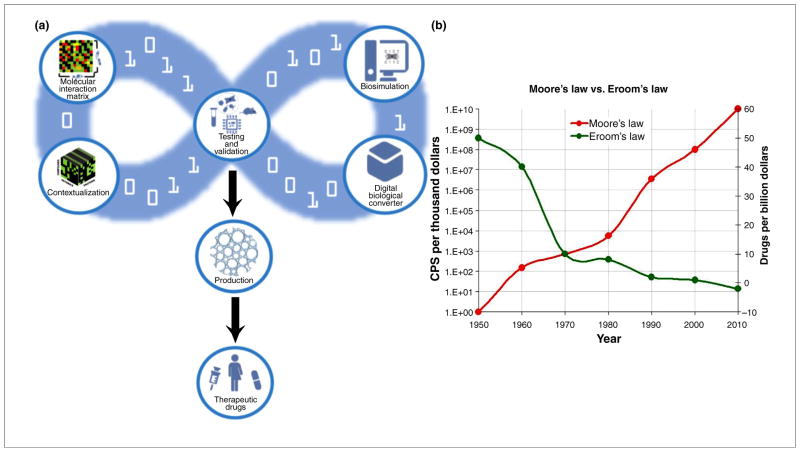FIGURE 5.
The Computational Analysis of Novel Drug Opportunities (CANDO) platform enables Moore’s law in drug discovery. (a) Integration of digital biological converter [6,11,69–72,77–79], cell and/or organ chips [6,67,73,74,80,81] and cell-free protein synthesis (CFPS) [76,82,83] into the CANDO platform, enabling a potentially rapid and cost-effective pharmacotherapeutic drug prototyping, development, distribution and production system. (b) Moore’s versus Eroom’s law (Moore’s law backwards): the power of computing per unit costs doubles every 18 months under Moore’s Law, whereas the unit cost of drug development has increased to the point where drug development has become nearly cost ineffective, following an inverse of Moore’s law (Eroom’s law). It is not inconceivable that one of the reasons for the current lack of success in finding new pharmacotherapeutics in a time- and cost-effective manner is the current model-driven memes in the industry. Although the information technology industry has doubled its effectiveness per unit cost every 18 months since the beginning of the digital age during the late 1950s, following Moore’s law, the pharmaceutical industry, even with the advent of biotechnology, has doubled its cost for the development of new drugs every decade since the 1950s. Today, it is nearly impossible to develop a new drug in less than a decade and for less than US$1 billion [32], whereas powerful and inexpensive hand-held computing devices (i.e. smartphones) are now owned and used today by nearly 60% of the people on Earth. Integration of biological hardware with the CANDO platform seems essential for faster, safer, better and cheaper drug discovery much in the same way as the microprocessor was for the computer industry and information systems.

